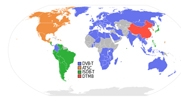Moves for global unification of digital terrestrial gather pace

Plans to unify global digital terrestrial transmission under a single next generation standard are being advanced by the Future of Broadcast Television Summit (FOBTV) organization supported by leading broadcasting groups.
This would mean each of the four current regional DTT regimes converging on a single future platform, which will bring various advantages but also considerable challenges on the way. These points were outlined last week by Mark S. Richer Advanced Television Systems CommiAee, Mark S. Richer Advanced Television Systems CommiAee,Mark Richer from the American Television Systems Committee (ATSC) at the Digital Video Broadcast (DVB) World 2012 conference in Rome, Italy.
Advantages include economies of scale, both in manufacture of devices and in the development of technologies that maximize spectral efficiency and optimize convergence with Internet-based interactive services, which is essential for the future of DTT. A single standard will also help meet objectives such as worldwide portability of terrestrial receiving devices, automatic adjustment to changes in transmission parameters and device wake up in an emergency. All these could be achieved under the current four regimes, but only with considerably greater complexity and, therefore, cost. Equally important, according to Richer, was the message this would send out from broadcasters around the world that they really mean business with digital terrestrial, and will combine forces to continue advancing standards and technologies, rather than being fragmented as at present.
Among the challenges is the fact that the new standard will have to meet the slightly differing objectives of the various regions and bring them back to a common point. The fact that, currently, there are four DTT standards reflects that it was possible for that to happen in a world of several distinct land masses. The desire for convergence reflects the increasingly global nature of the broadcast industry and the trend towards TV Everywhere, with services increasingly being received on handheld devices that will cross between DTT regions.
The biggest challenge lies in making the next generation of DTT so much better than the present one that it is worth migrating to it, even though it can no longer be backwards compatible with the existing ones if it is to be adopted uniformly all over the world. There is growing conviction that it will be worth it, since FOBTV enjoys support from almost all the main broadcasting related standards groups including ATSC, Communications Research Centre, European Broadcast Union, Electronics and Telecommunications Research Institute, Institute of Electronic and Electrical Engineers, National Association of Broadcasters, and Japan Broadcasting Corporation.
FOBTV held its first meeting in Shanghai, China, in November 2011, where broadcasting executives, technologists and engineers agreed to collaborate on a global approach to the future of terrestrial TV.
Get the TV Tech Newsletter
The professional video industry's #1 source for news, trends and product and tech information. Sign up below.
